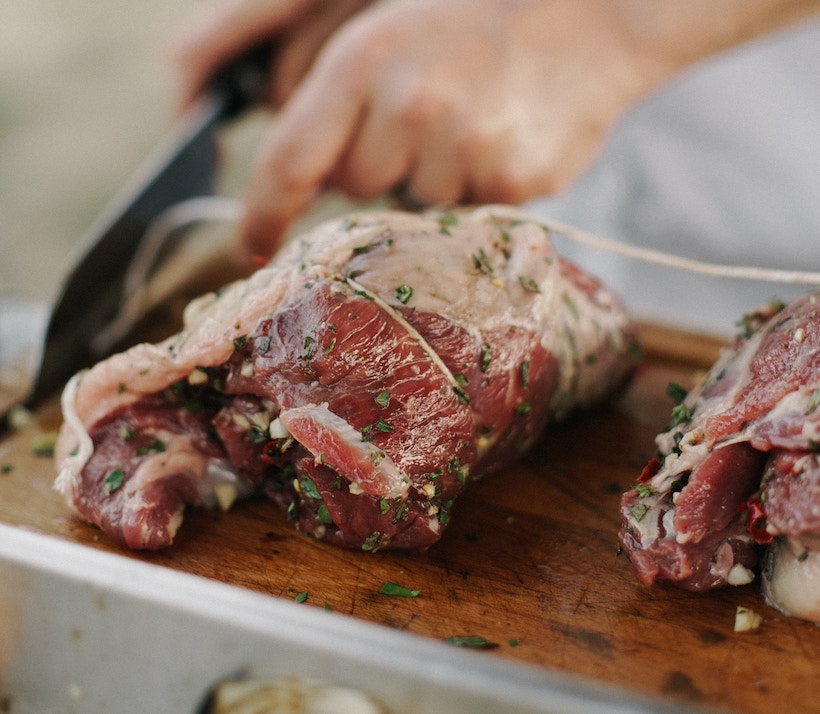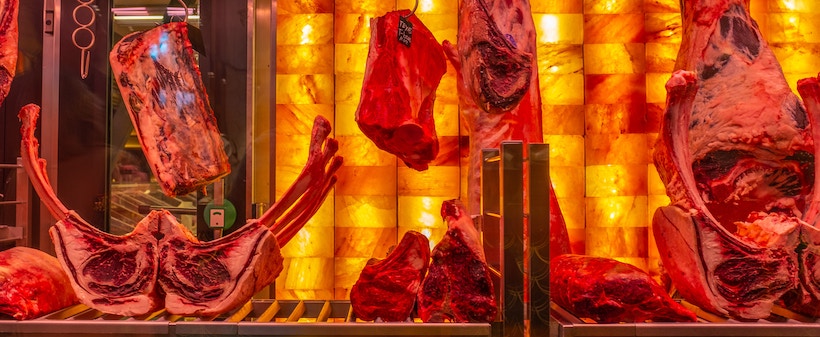In a hurry? My top choice for best butcher knife is the Cutco Model 1722 butcher knife. If you are on a budget, my value pick for best butcher knife is the Victorinox Swiss Army Cutlery Butcher Knife.
If you buy a lot of meat at once (like me!) or find yourself often butchering at home, it's time to look for a butcher knife. Of course, that assumes you know what to look for while searching.
In this post, I'll provide a simple buyer's guide to follow to find the best butcher knife for your needs, plus a roundup of five top knives. Let's cut to the chase!

While you can get ceramic butcher's knives, the most popular formulation of butcher knife blades are stainless steel. Stainless is a classic knife blade material for good reason – just like the name suggests, they are good at fighting stains, rust, and corrosion – perfect for kitchen usage.
The highest quality knife blades use high carbon steel.
While more vulnerable to corrosion than pure stainless steel, they stay sharper longer, are heavy-duty, and are chosen to be used in professional kitchens often due to their reliability.
Your choice in handle comes down to personal preference as well as the quality of the knife. The three most used materials for butcher knife handles are:
Plastic handles are generally the cheapest when it comes to quality (and price) and sometimes feel a little tacky and uncomfortable when holding the knife.
Wood handles are the more traditional choice. They can be relatively sturdy and adapt well to your hand, especially with higher usage.
I find resin to be the highest quality material because of its durability and comfort.
Blade length is one of the critical things to consider since buying the wrong-sized blade can make cutting challenging and awkward. Thankfully, most butcher knives are 10 inches long, although some are smaller by a few inches.
If you are thinking about getting a smaller-sized knife, make sure you know what you're getting. Especially with more substantial cuts of meat, at least 10-inches is a good option, but 8-inches or smaller can work depending on what you often eat.
There are a few butcher knives that come with a few extras like a sheath.
Sheaths can keep the blade protected while it is being stored or transported – if they are made to fit and of decent quality. Most are made with a thin plastic that can be somewhat protective, but the best ones are thicker and more durable.
Butcher knives are specially designed to cut large meat and roasts that other knives have a hard time cutting.
If you are looking for a knife that is excellent at trimming meats and removing fat, you have the extra reassurance that the knife can be used for carving and butchering meats should the need arise.
Other than the features listed above, the only other feature that you might want to look at is the length of the handle. If you have smaller hands, a large-handled knife probably isn't best for you. Mismatching length of handle and your hand size will reduce the amount of control you have while holding the knife.
Luckily, most butcher knife handles are smaller than 5 inches long, and these work decently for people with big or small hands. If you do have larger hands and you cannot comfortably handle a 5-inch handle (or smaller), there are a few knives out there that have larger handles.

First, always make sure that you have a tight grip on the butcher's knife handle at all times. A popular way to handle a butcher knife is called the pinch grip, where you have your pointer finger on one side of the handle while your thumb is on the other side (it will look like you are "pinching" the handle).
Remember these tips while using the knife:
Yes, since they are significantly better at slicing large meats than other knives or scissors. Some people use scissors to cut or trim meats, and a butcher's knife is often vastly superior.
Not only this, but they are durable and can last for quite a long time since they are designed only to cut large, tough meats.
As always, this is a knife, so treat it like any other knife. If you have never used a butcher knife before, know that they can be slightly – or much – heavier than a regular knife.
Before you start cutting, it is a good idea to get used to the weight of the knife. That way, you are less likely to mishandle or drop it and injure yourself.
If you love the classic-looking knife with natural wood handles and a blade with accenting black lines from oxidation, then the Ontario Knife 7111 Butcher's Knife may be the knife for you.
Made from high carbon steel, the blade does require some special care to keep it protected. It needs to be cleaned shortly after being used and then dried immediately after. Otherwise, it can develop rust quite easily. Also, take care to oil it properly.
It does have one of the sharpest blades compared to the knives both on and off this list. Those of you who are looking for a good butcher knife for hunting, this might be one of the best you can get. It cuts through wild game better than most knives out there.
This knife does not come with a sheath.
Pros:
Cons:
The Dexter-Russell S112-10PCP Butcher Knife is a high quality option for quality butchering. The white plastic handle could look a bit cheap to some owners, but it has a good grip and is easy to clean. It is a great, sharp knife and can easily cut through thick or thin meats like chicken, pigs, cows, and fish very well.
This knife is also one of the only ones on this list that is made of stainless steel and not high carbon steel (stainless or otherwise). Because of this, it is a bit easier to unintentionally bend the blade while making deep cuts into tough meat, making it not the best for butchering wild game.
Even so, the S112-10PCP has years of history and happy owners who report it cuts exceptionally well. So, if you are looking for a knife that lasts longer than most and you do not mind a plastic handle, this may be the one for you.
Since it does not come with a sheath, you may want to consider getting one as it can help preserve the knife or protect your fingers when it is stored or moved.
Pros:
Cons:
It is hard to find someone who has never heard of a Cutco knife or knife set, especially since their rise in popularity since the late '90s and early 2000s. They can tend towards the more expensive side, but they are also among the most durable and long-lasting knife brands.
Some users have had the Cutco Model 1722 (possibly in a knife set) for nearly twenty years and report it still cuts amazingly. The long lifespan is credit to the high carbon stainless steel material and the unique resin handle that is damage resistant.
Unlike a traditional knife which has brass rivets, this butcher knife has nickel-silver alloy rivets, which look more aesthetically pleasing than brass, in my opinion.
The tip of the blade is probably one of the sharpest on this list, making it excellent for trimming fat. The longer than average curve beside the tip is incredibly helpful for trimming meats too.
Unfortunately, like the others on the list, this knife does not come with a sheath, but it can fit into many knife blocks.
Pros:
Cons:
If you want a sturdy, unbending knife that can cut through the thickest meats or large, tough wild game, take a look at the Victorinox Swiss Army Cutlery Fibrox Pro Butcher Knife. Coming with a lifetime guarantee, this knife is the only one on the list that has a Granton edge. A Granton edge is the scalloping near the blade edge you can see in the picture – these pockets introduce air to your cuts to make it less likely meat sticks to the blade.
The blade is constructed of high carbon stainless European steel. The handle is made from Fibrox, a Swiss patented material that feels unique; not like plastic, wood, or resin. Although it is difficult to describe, you could say that the handle feels "firm," not as smooth as resin or wood, yet smoother than some plastic handles.
One wonderful thing about this knife is it is also available in other sizes – eight and twelve inches – and is available with or without the aforementioned Granton edge. As with the other knives on this list, it does not come with a sheath.
Pros:
Cons:
The Dalstrong Butcher Breaking Knife's blade is made from high carbon stainless steel. Its handle is made from wood and contains silver rivets, and it cuts through some of the most robust meats practically by itself.
A nice differentiator for the Dalstrong option is it comes with a high-quality knife sheath. Unlike some flimsy sheaths, the Dalstrong's is made from thick plastic. It has a larger/broader end of the blade near its tip, making it harder to fit into a knife block than some other options above.
Users report the blade requires more sharpening with regular use when compared to other butcher's knives (both on and off the list). However, the light weight of the blade makes up for it since it can be more comfortable for some to handle.
Pros:
Cons:
When looking at the blade material, blade size, handle material, and extra features, my pick for best butcher's knife is the Cutco butcher knife. Despite being less affordable than other options, the quality blade and comfortable handle are unmatched by other knives.
All of the other knives either require more frequent maintenance or have a negative feature that knocked them out of the top place. If, however, you find that the Cutco out of reach of your price range, then the Victorinox Swiss Army Cutlery is my pick for top budget butcher's knife option.